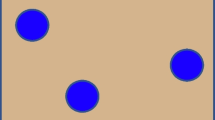Abstract
Using a serial reaction time task, this study examines whether learning of auditory sequences is possible without a corresponding motor response, i.e., by listening alone. The dual sequence paradigm used by Mayr (in Journal of the Experimental Psychology: Learning memory and cognition 22:350–354, 1996, Experiment 1) was adapted to the auditory domain. Four different actors spoke the same four colour words. These were presented such that speaker identity followed one sequence, and the word spoken followed a different sequence. Subjects were asked to respond (with a key press) to one of these dimensions (identity or word), and ignore the other. Results showed learning for either type of stimulus, but only when it was responded to. No learning of either type of auditory sequence by listening alone was found. The results add evidence to visual implicit learning studies that have failed to find learning of event sequences when spatial or response selection was not an important factor in processing. The findings are discussed in the context of implicit learning as a general and fundamental cognitive process.


Similar content being viewed by others
References
Buchner, A. & Frensch, P.A. (1997). Sequence learning. Phenomena and models. Psychological Research, 60, 1–3.
Buchner, A., Steffens, M.C., Erdfelder, E. & Rothkegel, R. (1997). A multinomial model to assess fluency and recollection in a sequence learning task. Quarterly Journal of Experimental Psychology, 50A, 631–663.
Buchner, A., Steffens, M.C. & Rothkegel, R. (1998). On the role of fragmentary knowledge in a sequence learning task. Quarterly Journal of Experimental Psychology, 51A, 251–281.
Heuer, H., Schmidtke, V. & Kleinsorge, T. (2001). Implicit learning of Sequences of Tasks..Journal of Experimental Psychology: Learning, Memory, and Cognition, 27(4) , 967–983.
Howard, J.H., Mutter, S.A. & Howard, D.V. (1992). Serial pattern learning by event observation. Journal of Experimental Psychology: Learning, Memory, and Cognition, 18(5) , 109–1039.
Jacoby, L.L. (1991). A process dissociation framework: separating automatic from intentional uses of memory. Journal of Memory and Language, 30, 513–541.
Jimenez, L. & Mendez, C. (1999). Which attention is needed for implicit sequence learning. Journal of Experimental Psychology: Learning, Memory, and Cognition, 25(1) , 236–259.
Kelly, S.W. & Burton, A.M. (2001). Learning complex sequences by observation? Psychological Research, 65, 15–23.
Kelly, S.W., Burton, A.M., Riedel, B & Lynch, E. (2003). Sequence learning by observation: evidence for separate mechanisms. British Journal of Psychology, 94 (3), 355–372.
Koch, I. & Hoffmann, J. (2000). The role of stimulus-based and response-based spatial information in sequence learning. Journal of Experimental Psychology: Learning, Memory, and Cognition, 26(4), 863–882.
Mayr, U. (1996). Spatial attention and implicit sequence learning: evidence for independent learning of spatial and nonspatial sequences. Journal of Experimental Psychology: Learning, Memory and Cognition, 22, 350–364.
Mondor, T.A. & Bregman, A.S. (1994). Allocating attention to frequency regions. Perception and Psychophysics, 56(3), 268–276.
Mondor, T.A. & Zatorre, R.J. (1994). Shifting and focusing auditory spatial attention. Journal of Experimental Psychology: Human Perception and Performance, 21(2), 387–409.
Newell, B.R. & Bright, J.E.H. (2002). Well past midnight: calling time on implicit invariant learning? European Journal of Cognitive Psychology, 14(2), 185–205.
Nissen, M.J. & Bullemer, P. (1987). Attentional requirements of learning: evidence from performance measures. Cognitive Psychology, 19, 1–32.
Perruchet, P. & Pacteau, C. (1990). Synthetic grammar learning: implicit rule abstraction or explicit fragmentary knowledge? Journal of Experimental Psychology: General, 19, 264–275.
Perruchet, P., Bigand, E. & Benoit-Gonin, F. (1997). The emergence of explicit knowledge during the early phase of learning in sequential reaction time tasks. Psychological Research, 60, 87–97.
Reber, A.S. (1967). Implicit learning of artificial grammars. Journal of Verbal Learning and Verbal Behaviour, 6, 855–863.
Reber, A.S. (1989). Implicit learning and tacit knowledge. Journal of Experimental Psychology: General, 118, 219–235.
Reber, A.S. (1993). Implicit learning and tacit knowledge: an essay on the cognitive unconscious. New York: Oxford University Press.
Reber, A.S. (1994). What manner of mind is this? Behavioral and Brain Sciences, 17(3) , 418–419.
Saffran, J.R., Johnson, E.K., Aslin, R.N. & Newport, E.L. (1999). Statistical learning of tone sequences by human infants and adults. Cognition, 70, 27–52.
Schmidtke, V & Heuer, H. (1997). Task integration as a factor in secondary-task effects on sequence learning. Psychological Research, 60, 53–71.
Seger, C.A. (1997). Two forms of sequential implicit learning. Consciousness and Cognition, 6, 108–131.
Shanks, D.R. & Johnston, T. (1999). Evaluating the relationship between explicit and implicit knowledge in a sequential reaction time task. Journal of Experimental Psychology: Learning, Memory, and Cognition, 25(6 ) , 1435–1451.
Willingham, D.B. (1999). Implicit motor sequence learning is not purely perceptual. Memory and Cognition, 27, 561–572.
Willingham, D.B., Nissen, M.J., Bullemer, P. (1989). On the development of procedural knowledge. Journal of Experimental Psychology: Learning, Memory, and Cognition, 15(6), 1047–1060.
Willingham, D.B., Wells, L.A., Farrell, J.M., Stemwedel, M.E. (2000). Implicit motor sequence learning is represented in response locations. Memory and Cognition, 28(3) , 366–375.
Author information
Authors and Affiliations
Corresponding author
Rights and permissions
About this article
Cite this article
Riedel, B., Burton, A.M. Auditory sequence learning: differential sensitivity to task relevant and task irrelevant sequences. Psychological Research 70, 337–344 (2006). https://doi.org/10.1007/s00426-005-0226-9
Received:
Accepted:
Published:
Issue Date:
DOI: https://doi.org/10.1007/s00426-005-0226-9




